Financial Analysis of GlaxoSmithKline Plc: Ratio and Trend Analysis
VerifiedAdded on 2020/10/05
|13
|3176
|481
Report
AI Summary
This report provides a comprehensive financial analysis of GlaxoSmithKline Plc, a major British pharmaceutical company. The analysis includes a detailed examination of the company's financial performance over a five-year period, utilizing ratio analysis to assess profitability, solvency, and other key financial metrics. Trend analysis is also employed to identify patterns and predict future performance. The report delves into GlaxoSmithKline's business and growth strategies, highlighting their focus on innovation, technology, and strategic partnerships. Furthermore, it discusses the limitations of both ratio and trend analysis. The report includes a comparison of the company's financial performance over the last five years, discussing reasons for changes in financial performance, and concludes with an overview of the company's financial health and strategic direction. The report includes tables detailing ratio analysis, revenue changes, and horizontal and vertical analysis.
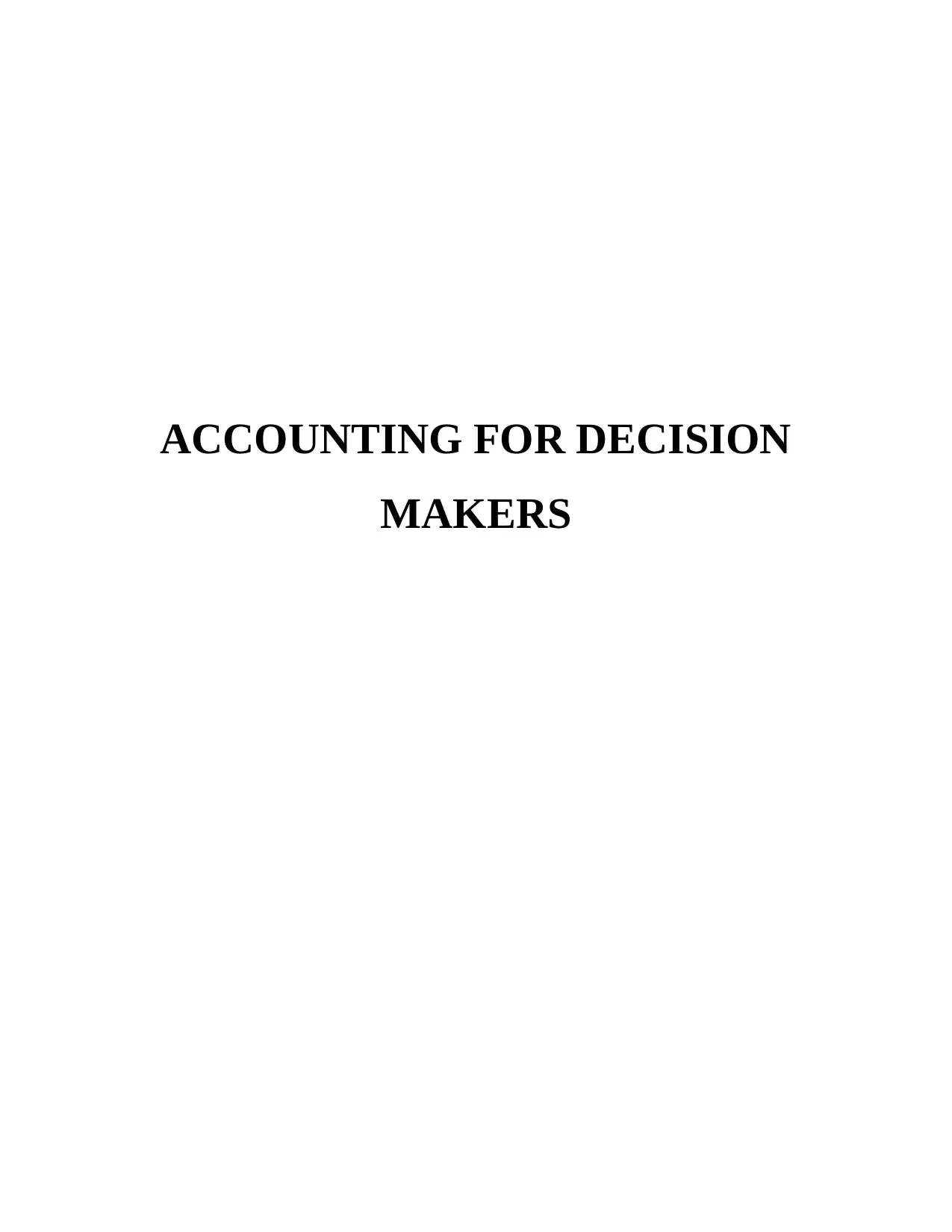
ACCOUNTING FOR DECISION
MAKERS
MAKERS
Paraphrase This Document
Need a fresh take? Get an instant paraphrase of this document with our AI Paraphraser
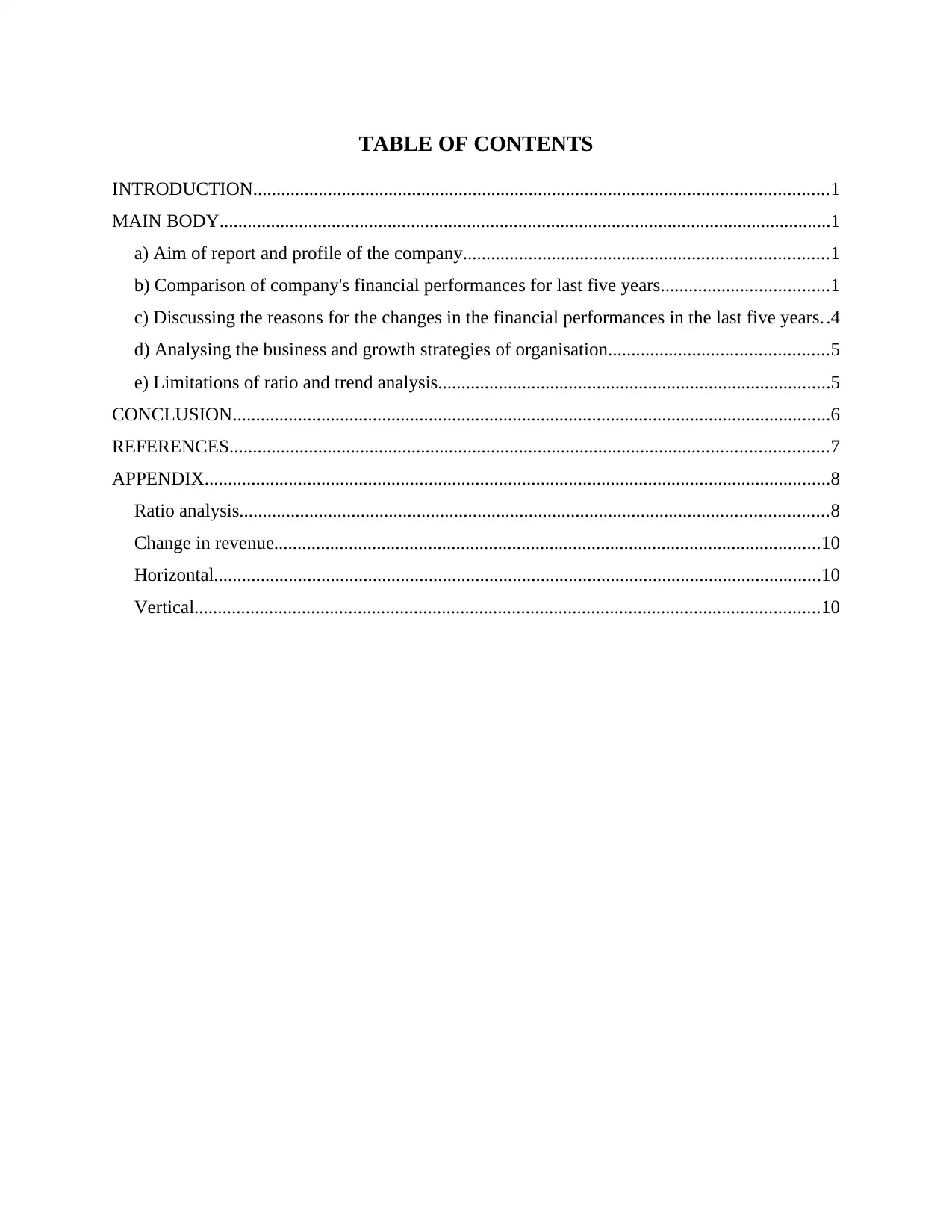
TABLE OF CONTENTS
INTRODUCTION...........................................................................................................................1
MAIN BODY...................................................................................................................................1
a) Aim of report and profile of the company..............................................................................1
b) Comparison of company's financial performances for last five years....................................1
c) Discussing the reasons for the changes in the financial performances in the last five years..4
d) Analysing the business and growth strategies of organisation...............................................5
e) Limitations of ratio and trend analysis....................................................................................5
CONCLUSION................................................................................................................................6
REFERENCES................................................................................................................................7
APPENDIX......................................................................................................................................8
Ratio analysis..............................................................................................................................8
Change in revenue.....................................................................................................................10
Horizontal..................................................................................................................................10
Vertical......................................................................................................................................10
INTRODUCTION...........................................................................................................................1
MAIN BODY...................................................................................................................................1
a) Aim of report and profile of the company..............................................................................1
b) Comparison of company's financial performances for last five years....................................1
c) Discussing the reasons for the changes in the financial performances in the last five years..4
d) Analysing the business and growth strategies of organisation...............................................5
e) Limitations of ratio and trend analysis....................................................................................5
CONCLUSION................................................................................................................................6
REFERENCES................................................................................................................................7
APPENDIX......................................................................................................................................8
Ratio analysis..............................................................................................................................8
Change in revenue.....................................................................................................................10
Horizontal..................................................................................................................................10
Vertical......................................................................................................................................10
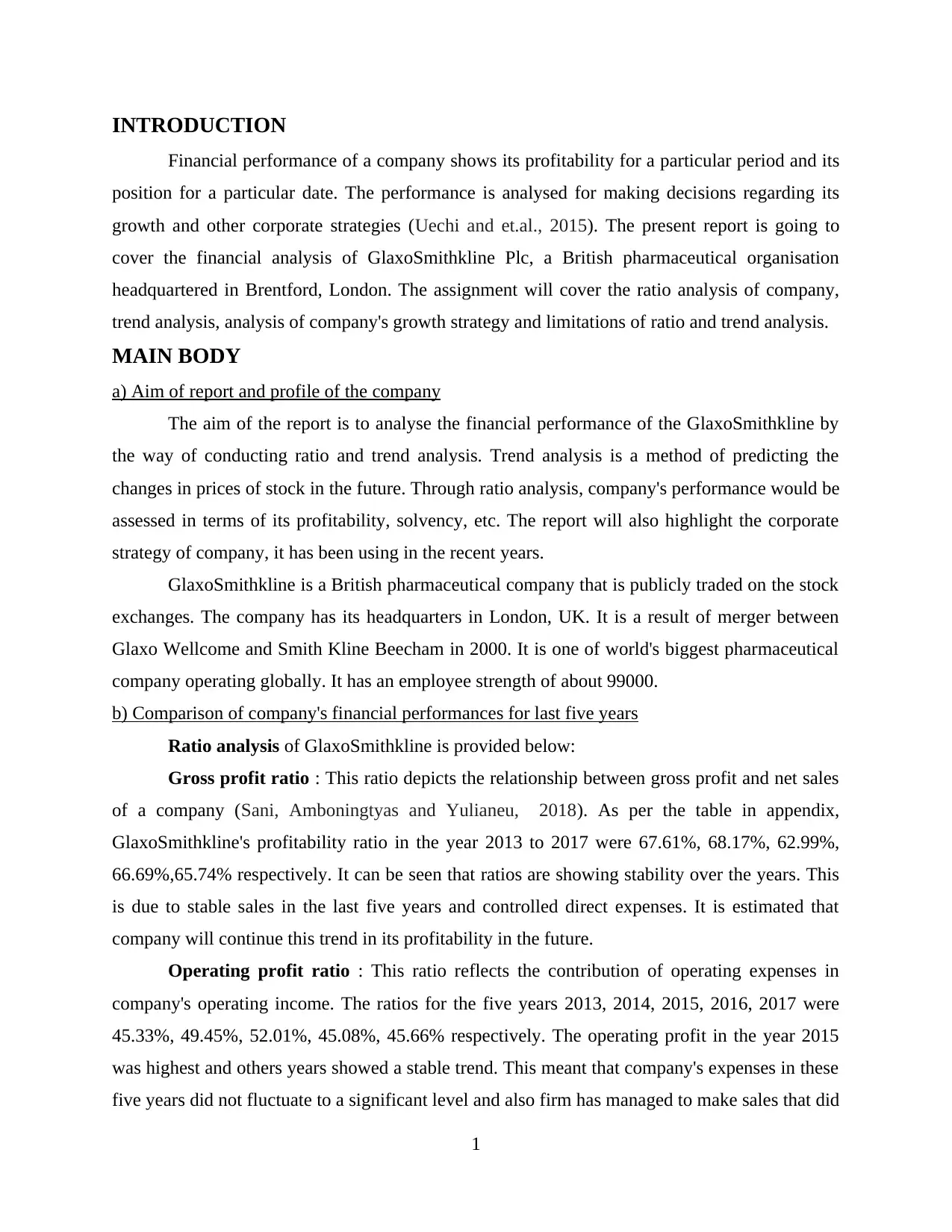
INTRODUCTION
Financial performance of a company shows its profitability for a particular period and its
position for a particular date. The performance is analysed for making decisions regarding its
growth and other corporate strategies (Uechi and et.al., 2015). The present report is going to
cover the financial analysis of GlaxoSmithkline Plc, a British pharmaceutical organisation
headquartered in Brentford, London. The assignment will cover the ratio analysis of company,
trend analysis, analysis of company's growth strategy and limitations of ratio and trend analysis.
MAIN BODY
a) Aim of report and profile of the company
The aim of the report is to analyse the financial performance of the GlaxoSmithkline by
the way of conducting ratio and trend analysis. Trend analysis is a method of predicting the
changes in prices of stock in the future. Through ratio analysis, company's performance would be
assessed in terms of its profitability, solvency, etc. The report will also highlight the corporate
strategy of company, it has been using in the recent years.
GlaxoSmithkline is a British pharmaceutical company that is publicly traded on the stock
exchanges. The company has its headquarters in London, UK. It is a result of merger between
Glaxo Wellcome and Smith Kline Beecham in 2000. It is one of world's biggest pharmaceutical
company operating globally. It has an employee strength of about 99000.
b) Comparison of company's financial performances for last five years
Ratio analysis of GlaxoSmithkline is provided below:
Gross profit ratio : This ratio depicts the relationship between gross profit and net sales
of a company (Sani, Amboningtyas and Yulianeu, 2018). As per the table in appendix,
GlaxoSmithkline's profitability ratio in the year 2013 to 2017 were 67.61%, 68.17%, 62.99%,
66.69%,65.74% respectively. It can be seen that ratios are showing stability over the years. This
is due to stable sales in the last five years and controlled direct expenses. It is estimated that
company will continue this trend in its profitability in the future.
Operating profit ratio : This ratio reflects the contribution of operating expenses in
company's operating income. The ratios for the five years 2013, 2014, 2015, 2016, 2017 were
45.33%, 49.45%, 52.01%, 45.08%, 45.66% respectively. The operating profit in the year 2015
was highest and others years showed a stable trend. This meant that company's expenses in these
five years did not fluctuate to a significant level and also firm has managed to make sales that did
1
Financial performance of a company shows its profitability for a particular period and its
position for a particular date. The performance is analysed for making decisions regarding its
growth and other corporate strategies (Uechi and et.al., 2015). The present report is going to
cover the financial analysis of GlaxoSmithkline Plc, a British pharmaceutical organisation
headquartered in Brentford, London. The assignment will cover the ratio analysis of company,
trend analysis, analysis of company's growth strategy and limitations of ratio and trend analysis.
MAIN BODY
a) Aim of report and profile of the company
The aim of the report is to analyse the financial performance of the GlaxoSmithkline by
the way of conducting ratio and trend analysis. Trend analysis is a method of predicting the
changes in prices of stock in the future. Through ratio analysis, company's performance would be
assessed in terms of its profitability, solvency, etc. The report will also highlight the corporate
strategy of company, it has been using in the recent years.
GlaxoSmithkline is a British pharmaceutical company that is publicly traded on the stock
exchanges. The company has its headquarters in London, UK. It is a result of merger between
Glaxo Wellcome and Smith Kline Beecham in 2000. It is one of world's biggest pharmaceutical
company operating globally. It has an employee strength of about 99000.
b) Comparison of company's financial performances for last five years
Ratio analysis of GlaxoSmithkline is provided below:
Gross profit ratio : This ratio depicts the relationship between gross profit and net sales
of a company (Sani, Amboningtyas and Yulianeu, 2018). As per the table in appendix,
GlaxoSmithkline's profitability ratio in the year 2013 to 2017 were 67.61%, 68.17%, 62.99%,
66.69%,65.74% respectively. It can be seen that ratios are showing stability over the years. This
is due to stable sales in the last five years and controlled direct expenses. It is estimated that
company will continue this trend in its profitability in the future.
Operating profit ratio : This ratio reflects the contribution of operating expenses in
company's operating income. The ratios for the five years 2013, 2014, 2015, 2016, 2017 were
45.33%, 49.45%, 52.01%, 45.08%, 45.66% respectively. The operating profit in the year 2015
was highest and others years showed a stable trend. This meant that company's expenses in these
five years did not fluctuate to a significant level and also firm has managed to make sales that did
1
⊘ This is a preview!⊘
Do you want full access?
Subscribe today to unlock all pages.

Trusted by 1+ million students worldwide
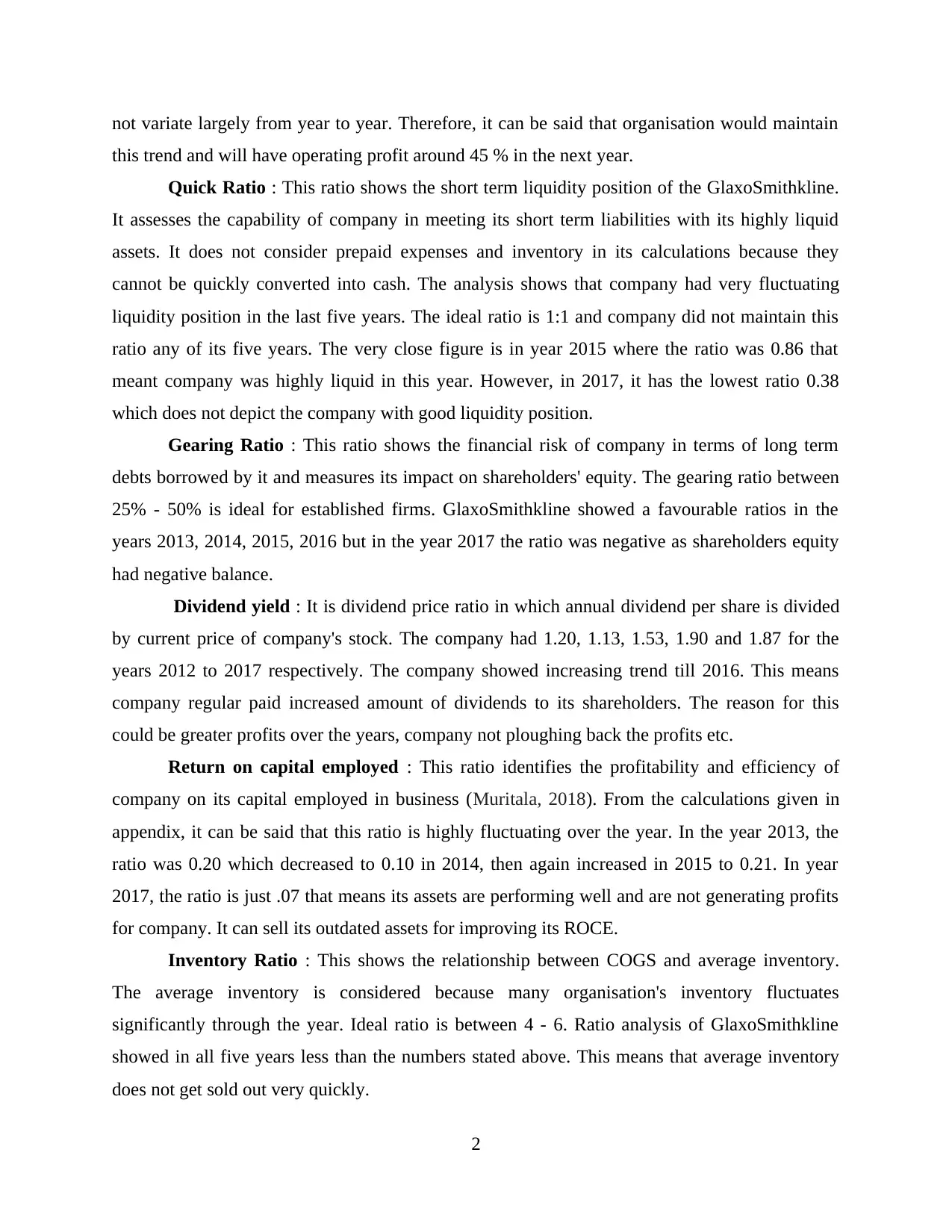
not variate largely from year to year. Therefore, it can be said that organisation would maintain
this trend and will have operating profit around 45 % in the next year.
Quick Ratio : This ratio shows the short term liquidity position of the GlaxoSmithkline.
It assesses the capability of company in meeting its short term liabilities with its highly liquid
assets. It does not consider prepaid expenses and inventory in its calculations because they
cannot be quickly converted into cash. The analysis shows that company had very fluctuating
liquidity position in the last five years. The ideal ratio is 1:1 and company did not maintain this
ratio any of its five years. The very close figure is in year 2015 where the ratio was 0.86 that
meant company was highly liquid in this year. However, in 2017, it has the lowest ratio 0.38
which does not depict the company with good liquidity position.
Gearing Ratio : This ratio shows the financial risk of company in terms of long term
debts borrowed by it and measures its impact on shareholders' equity. The gearing ratio between
25% - 50% is ideal for established firms. GlaxoSmithkline showed a favourable ratios in the
years 2013, 2014, 2015, 2016 but in the year 2017 the ratio was negative as shareholders equity
had negative balance.
Dividend yield : It is dividend price ratio in which annual dividend per share is divided
by current price of company's stock. The company had 1.20, 1.13, 1.53, 1.90 and 1.87 for the
years 2012 to 2017 respectively. The company showed increasing trend till 2016. This means
company regular paid increased amount of dividends to its shareholders. The reason for this
could be greater profits over the years, company not ploughing back the profits etc.
Return on capital employed : This ratio identifies the profitability and efficiency of
company on its capital employed in business (Muritala, 2018). From the calculations given in
appendix, it can be said that this ratio is highly fluctuating over the year. In the year 2013, the
ratio was 0.20 which decreased to 0.10 in 2014, then again increased in 2015 to 0.21. In year
2017, the ratio is just .07 that means its assets are performing well and are not generating profits
for company. It can sell its outdated assets for improving its ROCE.
Inventory Ratio : This shows the relationship between COGS and average inventory.
The average inventory is considered because many organisation's inventory fluctuates
significantly through the year. Ideal ratio is between 4 - 6. Ratio analysis of GlaxoSmithkline
showed in all five years less than the numbers stated above. This means that average inventory
does not get sold out very quickly.
2
this trend and will have operating profit around 45 % in the next year.
Quick Ratio : This ratio shows the short term liquidity position of the GlaxoSmithkline.
It assesses the capability of company in meeting its short term liabilities with its highly liquid
assets. It does not consider prepaid expenses and inventory in its calculations because they
cannot be quickly converted into cash. The analysis shows that company had very fluctuating
liquidity position in the last five years. The ideal ratio is 1:1 and company did not maintain this
ratio any of its five years. The very close figure is in year 2015 where the ratio was 0.86 that
meant company was highly liquid in this year. However, in 2017, it has the lowest ratio 0.38
which does not depict the company with good liquidity position.
Gearing Ratio : This ratio shows the financial risk of company in terms of long term
debts borrowed by it and measures its impact on shareholders' equity. The gearing ratio between
25% - 50% is ideal for established firms. GlaxoSmithkline showed a favourable ratios in the
years 2013, 2014, 2015, 2016 but in the year 2017 the ratio was negative as shareholders equity
had negative balance.
Dividend yield : It is dividend price ratio in which annual dividend per share is divided
by current price of company's stock. The company had 1.20, 1.13, 1.53, 1.90 and 1.87 for the
years 2012 to 2017 respectively. The company showed increasing trend till 2016. This means
company regular paid increased amount of dividends to its shareholders. The reason for this
could be greater profits over the years, company not ploughing back the profits etc.
Return on capital employed : This ratio identifies the profitability and efficiency of
company on its capital employed in business (Muritala, 2018). From the calculations given in
appendix, it can be said that this ratio is highly fluctuating over the year. In the year 2013, the
ratio was 0.20 which decreased to 0.10 in 2014, then again increased in 2015 to 0.21. In year
2017, the ratio is just .07 that means its assets are performing well and are not generating profits
for company. It can sell its outdated assets for improving its ROCE.
Inventory Ratio : This shows the relationship between COGS and average inventory.
The average inventory is considered because many organisation's inventory fluctuates
significantly through the year. Ideal ratio is between 4 - 6. Ratio analysis of GlaxoSmithkline
showed in all five years less than the numbers stated above. This means that average inventory
does not get sold out very quickly.
2
Paraphrase This Document
Need a fresh take? Get an instant paraphrase of this document with our AI Paraphraser
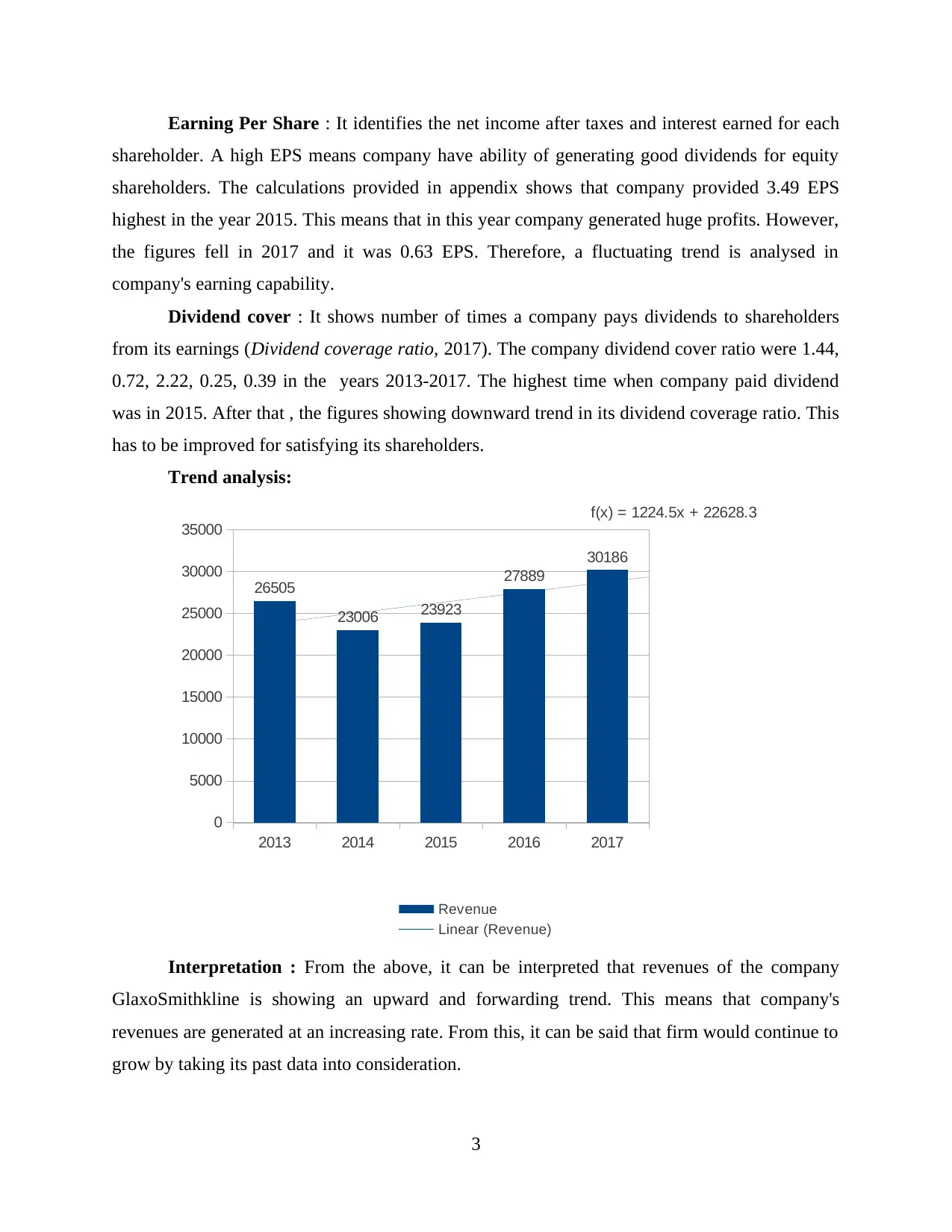
Earning Per Share : It identifies the net income after taxes and interest earned for each
shareholder. A high EPS means company have ability of generating good dividends for equity
shareholders. The calculations provided in appendix shows that company provided 3.49 EPS
highest in the year 2015. This means that in this year company generated huge profits. However,
the figures fell in 2017 and it was 0.63 EPS. Therefore, a fluctuating trend is analysed in
company's earning capability.
Dividend cover : It shows number of times a company pays dividends to shareholders
from its earnings (Dividend coverage ratio, 2017). The company dividend cover ratio were 1.44,
0.72, 2.22, 0.25, 0.39 in the years 2013-2017. The highest time when company paid dividend
was in 2015. After that , the figures showing downward trend in its dividend coverage ratio. This
has to be improved for satisfying its shareholders.
Trend analysis:
2013 2014 2015 2016 2017
0
5000
10000
15000
20000
25000
30000
35000
26505
23006 23923
27889
30186
f(x) = 1224.5x + 22628.3
Revenue
Linear (Revenue)
Interpretation : From the above, it can be interpreted that revenues of the company
GlaxoSmithkline is showing an upward and forwarding trend. This means that company's
revenues are generated at an increasing rate. From this, it can be said that firm would continue to
grow by taking its past data into consideration.
3
shareholder. A high EPS means company have ability of generating good dividends for equity
shareholders. The calculations provided in appendix shows that company provided 3.49 EPS
highest in the year 2015. This means that in this year company generated huge profits. However,
the figures fell in 2017 and it was 0.63 EPS. Therefore, a fluctuating trend is analysed in
company's earning capability.
Dividend cover : It shows number of times a company pays dividends to shareholders
from its earnings (Dividend coverage ratio, 2017). The company dividend cover ratio were 1.44,
0.72, 2.22, 0.25, 0.39 in the years 2013-2017. The highest time when company paid dividend
was in 2015. After that , the figures showing downward trend in its dividend coverage ratio. This
has to be improved for satisfying its shareholders.
Trend analysis:
2013 2014 2015 2016 2017
0
5000
10000
15000
20000
25000
30000
35000
26505
23006 23923
27889
30186
f(x) = 1224.5x + 22628.3
Revenue
Linear (Revenue)
Interpretation : From the above, it can be interpreted that revenues of the company
GlaxoSmithkline is showing an upward and forwarding trend. This means that company's
revenues are generated at an increasing rate. From this, it can be said that firm would continue to
grow by taking its past data into consideration.
3

Changes in revenue
As per the tables provided in the appendix, various changes were noticed when the
figures were horizontally and vertically compared.
Horizontal analysis was done in which changes were recorded by taking current year as
base year. From the calculations, major negative changes were noticed in the year 2013-
14. The other years showed positive and favourable year.
Vertical analysis was also done where the revenues were taken 100%. Revenue
remained constant for all the calculations. These showed changes in respect to revenues.
The tables depicted significant changes in net operating income in the 5 years because of
high and fluctuating operating expenses such as administrative and selling expenses.
c) Discussing the reasons for the changes in the financial performances in the last five years
Company's financial position changed in the last few years and there are different reasons
cited for these variations. The revenue in the year 2012 was £26505 million which reduced to
£23006 millions. The reason for such decline was increase of competition, people becoming
more health conscious for eliminating the requirements of drugs. Increase in the prices of
products was also one reason of declined sales. In the year 2015 23923 millions pound was the
revenue which increased to 27889 million pounds in the year 2016. Evolving technology, greater
understanding of biology and genomics with different diseases led to the development of more
effective healthcare products. This affected the sales of company. The trend of increasing sales
continued in year 2017 and 2018 because of innovation in technology, R&D and positive
changes in demographics.
The operating profits of the company in the last few have shown mix trend where in year
2012, it was £5904 millions that reduced in year 2014 to £4306 millions. The reason for the fall
in this profit was decrease in sales and decreased gross profit. The declining continued in 2015
and the numbers fell to £2628 millions. The cause behind that was increase in the operating
expenses mainly in administrative expenses. However, the profits rose in the year 2016 and the
figures were £6026 millions which happened due to increase in sales and revenues and low
operating expenses. In the year 2017, operating profit was stable, sales and revenue also
increased (GlaxoSmithKline PLC ADR, 2019).
4
As per the tables provided in the appendix, various changes were noticed when the
figures were horizontally and vertically compared.
Horizontal analysis was done in which changes were recorded by taking current year as
base year. From the calculations, major negative changes were noticed in the year 2013-
14. The other years showed positive and favourable year.
Vertical analysis was also done where the revenues were taken 100%. Revenue
remained constant for all the calculations. These showed changes in respect to revenues.
The tables depicted significant changes in net operating income in the 5 years because of
high and fluctuating operating expenses such as administrative and selling expenses.
c) Discussing the reasons for the changes in the financial performances in the last five years
Company's financial position changed in the last few years and there are different reasons
cited for these variations. The revenue in the year 2012 was £26505 million which reduced to
£23006 millions. The reason for such decline was increase of competition, people becoming
more health conscious for eliminating the requirements of drugs. Increase in the prices of
products was also one reason of declined sales. In the year 2015 23923 millions pound was the
revenue which increased to 27889 million pounds in the year 2016. Evolving technology, greater
understanding of biology and genomics with different diseases led to the development of more
effective healthcare products. This affected the sales of company. The trend of increasing sales
continued in year 2017 and 2018 because of innovation in technology, R&D and positive
changes in demographics.
The operating profits of the company in the last few have shown mix trend where in year
2012, it was £5904 millions that reduced in year 2014 to £4306 millions. The reason for the fall
in this profit was decrease in sales and decreased gross profit. The declining continued in 2015
and the numbers fell to £2628 millions. The cause behind that was increase in the operating
expenses mainly in administrative expenses. However, the profits rose in the year 2016 and the
figures were £6026 millions which happened due to increase in sales and revenues and low
operating expenses. In the year 2017, operating profit was stable, sales and revenue also
increased (GlaxoSmithKline PLC ADR, 2019).
4
⊘ This is a preview!⊘
Do you want full access?
Subscribe today to unlock all pages.

Trusted by 1+ million students worldwide
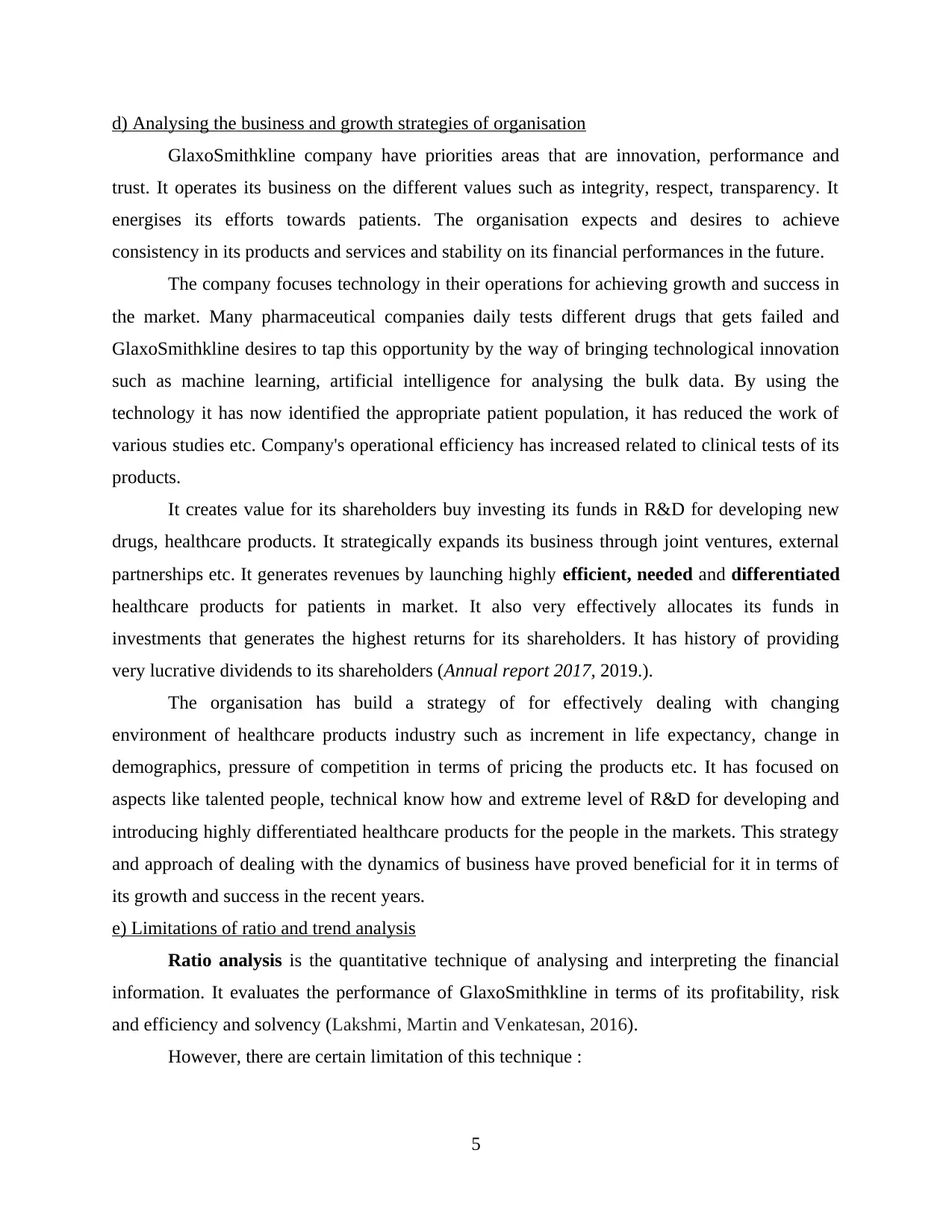
d) Analysing the business and growth strategies of organisation
GlaxoSmithkline company have priorities areas that are innovation, performance and
trust. It operates its business on the different values such as integrity, respect, transparency. It
energises its efforts towards patients. The organisation expects and desires to achieve
consistency in its products and services and stability on its financial performances in the future.
The company focuses technology in their operations for achieving growth and success in
the market. Many pharmaceutical companies daily tests different drugs that gets failed and
GlaxoSmithkline desires to tap this opportunity by the way of bringing technological innovation
such as machine learning, artificial intelligence for analysing the bulk data. By using the
technology it has now identified the appropriate patient population, it has reduced the work of
various studies etc. Company's operational efficiency has increased related to clinical tests of its
products.
It creates value for its shareholders buy investing its funds in R&D for developing new
drugs, healthcare products. It strategically expands its business through joint ventures, external
partnerships etc. It generates revenues by launching highly efficient, needed and differentiated
healthcare products for patients in market. It also very effectively allocates its funds in
investments that generates the highest returns for its shareholders. It has history of providing
very lucrative dividends to its shareholders (Annual report 2017, 2019.).
The organisation has build a strategy of for effectively dealing with changing
environment of healthcare products industry such as increment in life expectancy, change in
demographics, pressure of competition in terms of pricing the products etc. It has focused on
aspects like talented people, technical know how and extreme level of R&D for developing and
introducing highly differentiated healthcare products for the people in the markets. This strategy
and approach of dealing with the dynamics of business have proved beneficial for it in terms of
its growth and success in the recent years.
e) Limitations of ratio and trend analysis
Ratio analysis is the quantitative technique of analysing and interpreting the financial
information. It evaluates the performance of GlaxoSmithkline in terms of its profitability, risk
and efficiency and solvency (Lakshmi, Martin and Venkatesan, 2016).
However, there are certain limitation of this technique :
5
GlaxoSmithkline company have priorities areas that are innovation, performance and
trust. It operates its business on the different values such as integrity, respect, transparency. It
energises its efforts towards patients. The organisation expects and desires to achieve
consistency in its products and services and stability on its financial performances in the future.
The company focuses technology in their operations for achieving growth and success in
the market. Many pharmaceutical companies daily tests different drugs that gets failed and
GlaxoSmithkline desires to tap this opportunity by the way of bringing technological innovation
such as machine learning, artificial intelligence for analysing the bulk data. By using the
technology it has now identified the appropriate patient population, it has reduced the work of
various studies etc. Company's operational efficiency has increased related to clinical tests of its
products.
It creates value for its shareholders buy investing its funds in R&D for developing new
drugs, healthcare products. It strategically expands its business through joint ventures, external
partnerships etc. It generates revenues by launching highly efficient, needed and differentiated
healthcare products for patients in market. It also very effectively allocates its funds in
investments that generates the highest returns for its shareholders. It has history of providing
very lucrative dividends to its shareholders (Annual report 2017, 2019.).
The organisation has build a strategy of for effectively dealing with changing
environment of healthcare products industry such as increment in life expectancy, change in
demographics, pressure of competition in terms of pricing the products etc. It has focused on
aspects like talented people, technical know how and extreme level of R&D for developing and
introducing highly differentiated healthcare products for the people in the markets. This strategy
and approach of dealing with the dynamics of business have proved beneficial for it in terms of
its growth and success in the recent years.
e) Limitations of ratio and trend analysis
Ratio analysis is the quantitative technique of analysing and interpreting the financial
information. It evaluates the performance of GlaxoSmithkline in terms of its profitability, risk
and efficiency and solvency (Lakshmi, Martin and Venkatesan, 2016).
However, there are certain limitation of this technique :
5
Paraphrase This Document
Need a fresh take? Get an instant paraphrase of this document with our AI Paraphraser
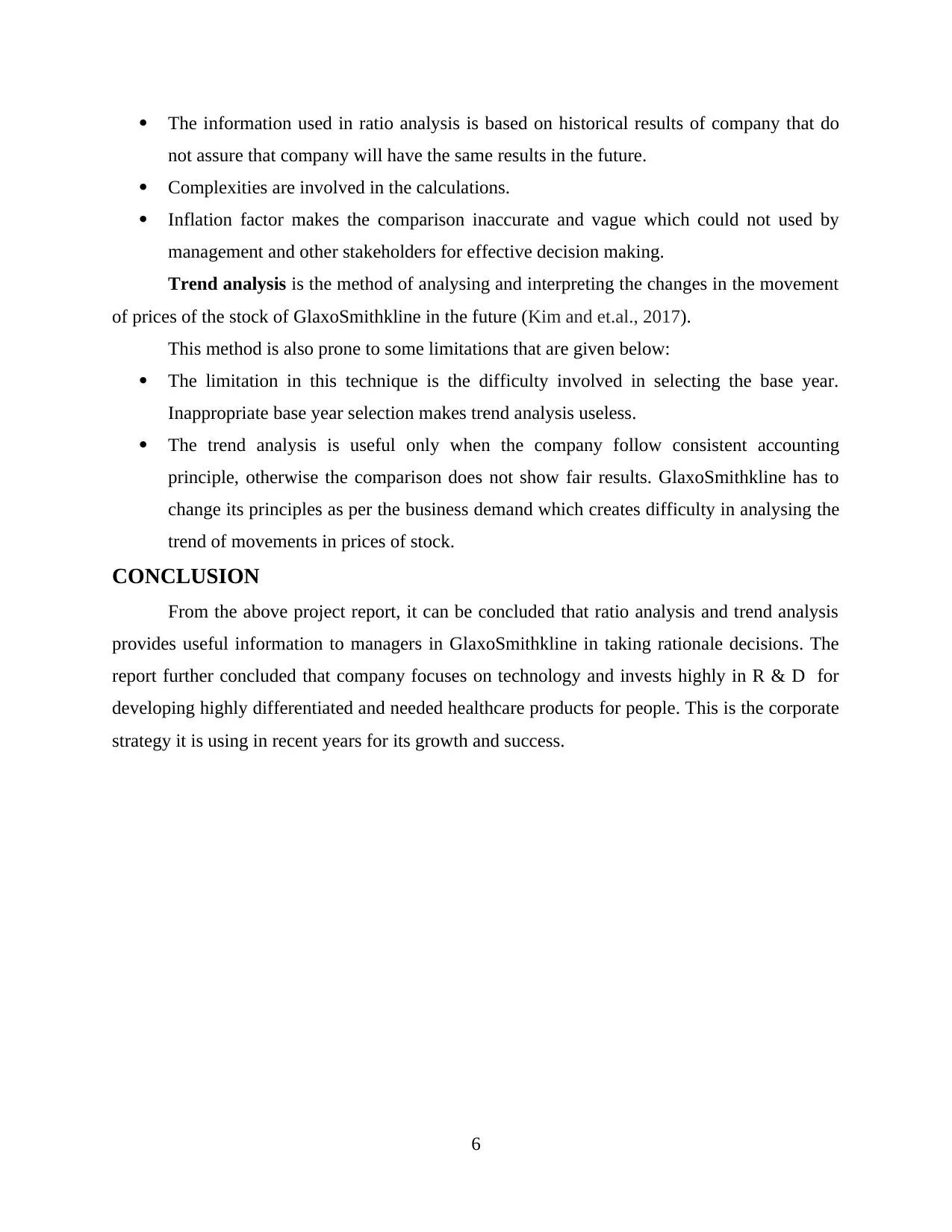
The information used in ratio analysis is based on historical results of company that do
not assure that company will have the same results in the future.
Complexities are involved in the calculations.
Inflation factor makes the comparison inaccurate and vague which could not used by
management and other stakeholders for effective decision making.
Trend analysis is the method of analysing and interpreting the changes in the movement
of prices of the stock of GlaxoSmithkline in the future (Kim and et.al., 2017).
This method is also prone to some limitations that are given below:
The limitation in this technique is the difficulty involved in selecting the base year.
Inappropriate base year selection makes trend analysis useless.
The trend analysis is useful only when the company follow consistent accounting
principle, otherwise the comparison does not show fair results. GlaxoSmithkline has to
change its principles as per the business demand which creates difficulty in analysing the
trend of movements in prices of stock.
CONCLUSION
From the above project report, it can be concluded that ratio analysis and trend analysis
provides useful information to managers in GlaxoSmithkline in taking rationale decisions. The
report further concluded that company focuses on technology and invests highly in R & D for
developing highly differentiated and needed healthcare products for people. This is the corporate
strategy it is using in recent years for its growth and success.
6
not assure that company will have the same results in the future.
Complexities are involved in the calculations.
Inflation factor makes the comparison inaccurate and vague which could not used by
management and other stakeholders for effective decision making.
Trend analysis is the method of analysing and interpreting the changes in the movement
of prices of the stock of GlaxoSmithkline in the future (Kim and et.al., 2017).
This method is also prone to some limitations that are given below:
The limitation in this technique is the difficulty involved in selecting the base year.
Inappropriate base year selection makes trend analysis useless.
The trend analysis is useful only when the company follow consistent accounting
principle, otherwise the comparison does not show fair results. GlaxoSmithkline has to
change its principles as per the business demand which creates difficulty in analysing the
trend of movements in prices of stock.
CONCLUSION
From the above project report, it can be concluded that ratio analysis and trend analysis
provides useful information to managers in GlaxoSmithkline in taking rationale decisions. The
report further concluded that company focuses on technology and invests highly in R & D for
developing highly differentiated and needed healthcare products for people. This is the corporate
strategy it is using in recent years for its growth and success.
6
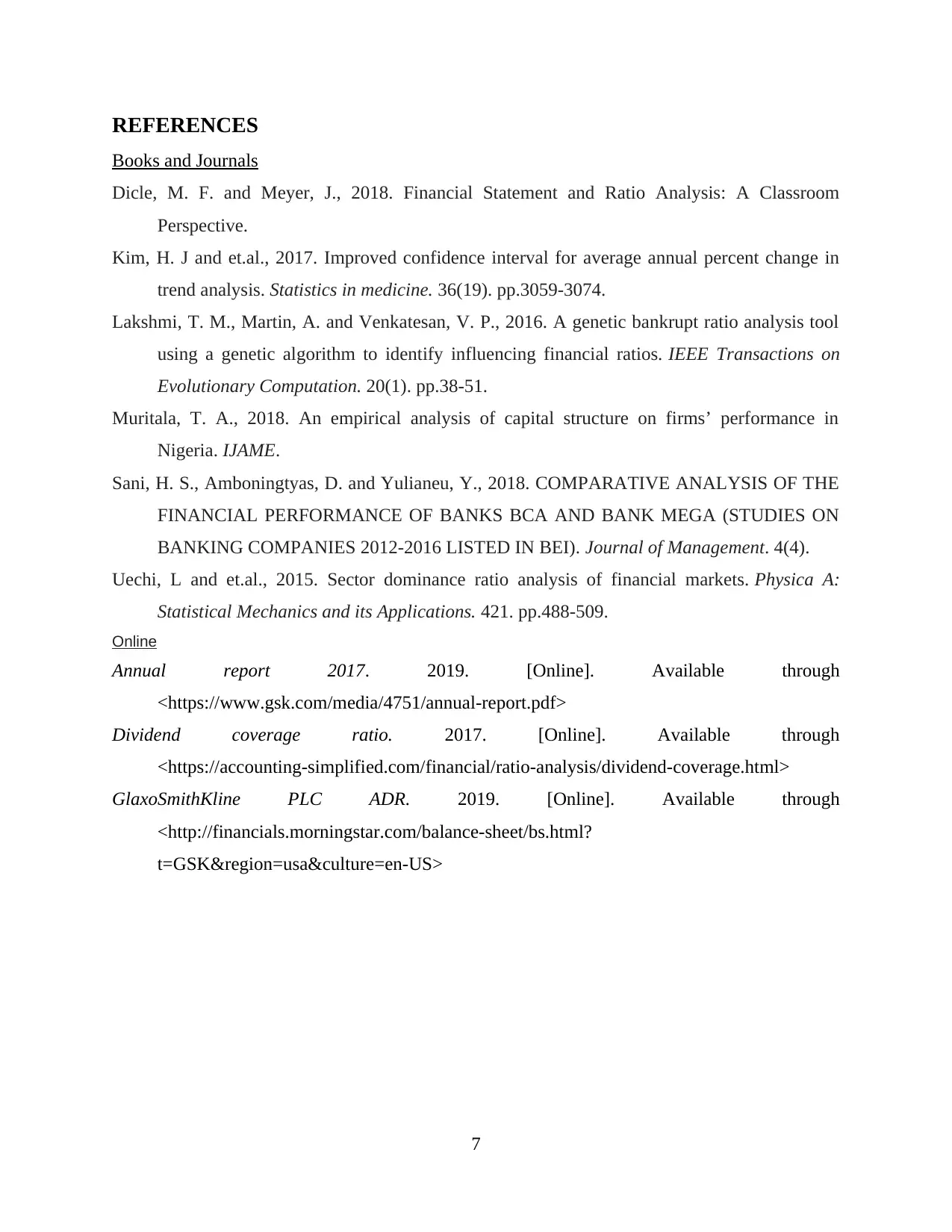
REFERENCES
Books and Journals
Dicle, M. F. and Meyer, J., 2018. Financial Statement and Ratio Analysis: A Classroom
Perspective.
Kim, H. J and et.al., 2017. Improved confidence interval for average annual percent change in
trend analysis. Statistics in medicine. 36(19). pp.3059-3074.
Lakshmi, T. M., Martin, A. and Venkatesan, V. P., 2016. A genetic bankrupt ratio analysis tool
using a genetic algorithm to identify influencing financial ratios. IEEE Transactions on
Evolutionary Computation. 20(1). pp.38-51.
Muritala, T. A., 2018. An empirical analysis of capital structure on firms’ performance in
Nigeria. IJAME.
Sani, H. S., Amboningtyas, D. and Yulianeu, Y., 2018. COMPARATIVE ANALYSIS OF THE
FINANCIAL PERFORMANCE OF BANKS BCA AND BANK MEGA (STUDIES ON
BANKING COMPANIES 2012-2016 LISTED IN BEI). Journal of Management. 4(4).
Uechi, L and et.al., 2015. Sector dominance ratio analysis of financial markets. Physica A:
Statistical Mechanics and its Applications. 421. pp.488-509.
Online
Annual report 2017. 2019. [Online]. Available through
<https://www.gsk.com/media/4751/annual-report.pdf>
Dividend coverage ratio. 2017. [Online]. Available through
<https://accounting-simplified.com/financial/ratio-analysis/dividend-coverage.html>
GlaxoSmithKline PLC ADR. 2019. [Online]. Available through
<http://financials.morningstar.com/balance-sheet/bs.html?
t=GSK®ion=usa&culture=en-US>
7
Books and Journals
Dicle, M. F. and Meyer, J., 2018. Financial Statement and Ratio Analysis: A Classroom
Perspective.
Kim, H. J and et.al., 2017. Improved confidence interval for average annual percent change in
trend analysis. Statistics in medicine. 36(19). pp.3059-3074.
Lakshmi, T. M., Martin, A. and Venkatesan, V. P., 2016. A genetic bankrupt ratio analysis tool
using a genetic algorithm to identify influencing financial ratios. IEEE Transactions on
Evolutionary Computation. 20(1). pp.38-51.
Muritala, T. A., 2018. An empirical analysis of capital structure on firms’ performance in
Nigeria. IJAME.
Sani, H. S., Amboningtyas, D. and Yulianeu, Y., 2018. COMPARATIVE ANALYSIS OF THE
FINANCIAL PERFORMANCE OF BANKS BCA AND BANK MEGA (STUDIES ON
BANKING COMPANIES 2012-2016 LISTED IN BEI). Journal of Management. 4(4).
Uechi, L and et.al., 2015. Sector dominance ratio analysis of financial markets. Physica A:
Statistical Mechanics and its Applications. 421. pp.488-509.
Online
Annual report 2017. 2019. [Online]. Available through
<https://www.gsk.com/media/4751/annual-report.pdf>
Dividend coverage ratio. 2017. [Online]. Available through
<https://accounting-simplified.com/financial/ratio-analysis/dividend-coverage.html>
GlaxoSmithKline PLC ADR. 2019. [Online]. Available through
<http://financials.morningstar.com/balance-sheet/bs.html?
t=GSK®ion=usa&culture=en-US>
7
⊘ This is a preview!⊘
Do you want full access?
Subscribe today to unlock all pages.

Trusted by 1+ million students worldwide
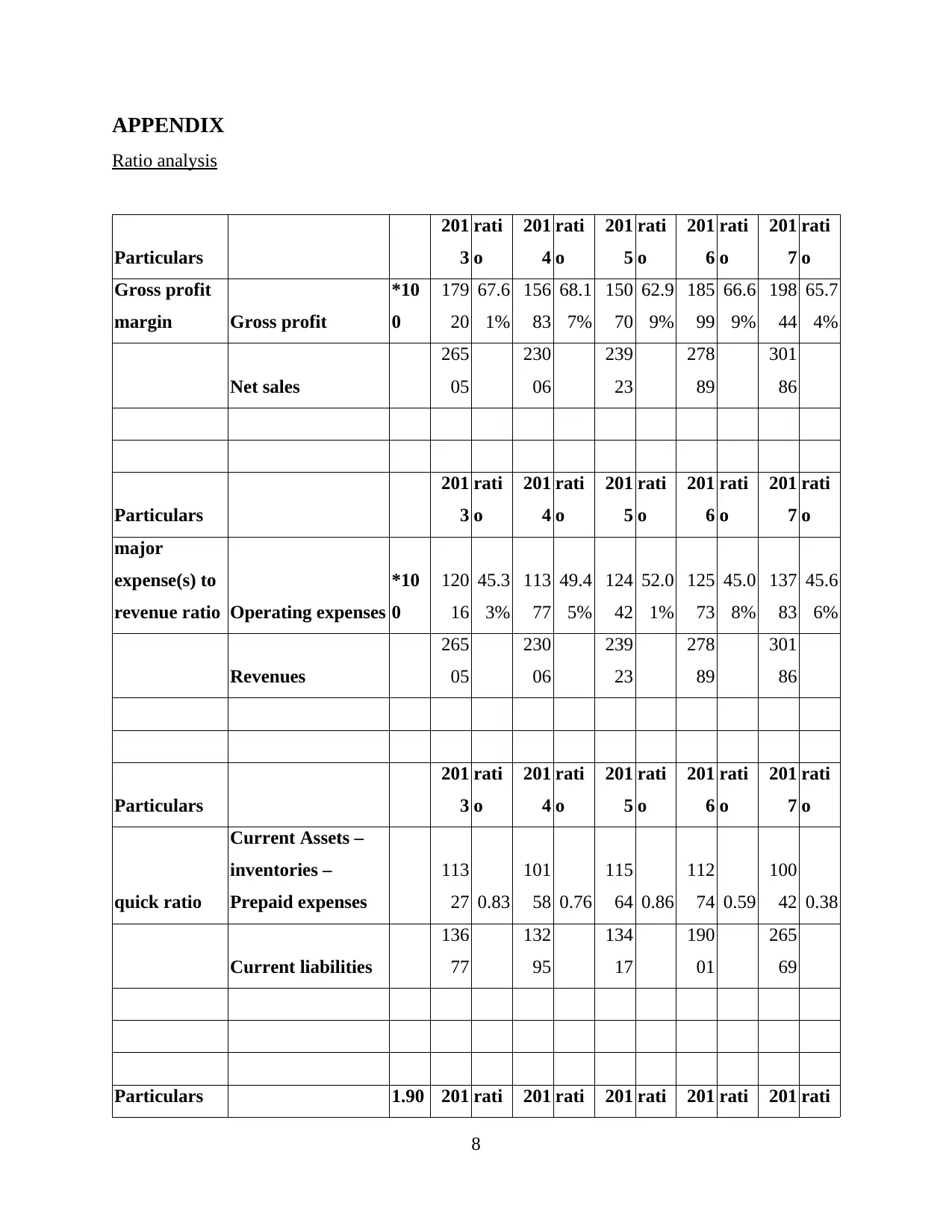
APPENDIX
Ratio analysis
Particulars
201
3
rati
o
201
4
rati
o
201
5
rati
o
201
6
rati
o
201
7
rati
o
Gross profit
margin Gross profit
*10
0
179
20
67.6
1%
156
83
68.1
7%
150
70
62.9
9%
185
99
66.6
9%
198
44
65.7
4%
Net sales
265
05
230
06
239
23
278
89
301
86
Particulars
201
3
rati
o
201
4
rati
o
201
5
rati
o
201
6
rati
o
201
7
rati
o
major
expense(s) to
revenue ratio Operating expenses
*10
0
120
16
45.3
3%
113
77
49.4
5%
124
42
52.0
1%
125
73
45.0
8%
137
83
45.6
6%
Revenues
265
05
230
06
239
23
278
89
301
86
Particulars
201
3
rati
o
201
4
rati
o
201
5
rati
o
201
6
rati
o
201
7
rati
o
quick ratio
Current Assets –
inventories –
Prepaid expenses
113
27 0.83
101
58 0.76
115
64 0.86
112
74 0.59
100
42 0.38
Current liabilities
136
77
132
95
134
17
190
01
265
69
Particulars 1.90 201 rati 201 rati 201 rati 201 rati 201 rati
8
Ratio analysis
Particulars
201
3
rati
o
201
4
rati
o
201
5
rati
o
201
6
rati
o
201
7
rati
o
Gross profit
margin Gross profit
*10
0
179
20
67.6
1%
156
83
68.1
7%
150
70
62.9
9%
185
99
66.6
9%
198
44
65.7
4%
Net sales
265
05
230
06
239
23
278
89
301
86
Particulars
201
3
rati
o
201
4
rati
o
201
5
rati
o
201
6
rati
o
201
7
rati
o
major
expense(s) to
revenue ratio Operating expenses
*10
0
120
16
45.3
3%
113
77
49.4
5%
124
42
52.0
1%
125
73
45.0
8%
137
83
45.6
6%
Revenues
265
05
230
06
239
23
278
89
301
86
Particulars
201
3
rati
o
201
4
rati
o
201
5
rati
o
201
6
rati
o
201
7
rati
o
quick ratio
Current Assets –
inventories –
Prepaid expenses
113
27 0.83
101
58 0.76
115
64 0.86
112
74 0.59
100
42 0.38
Current liabilities
136
77
132
95
134
17
190
01
265
69
Particulars 1.90 201 rati 201 rati 201 rati 201 rati 201 rati
8
Paraphrase This Document
Need a fresh take? Get an instant paraphrase of this document with our AI Paraphraser
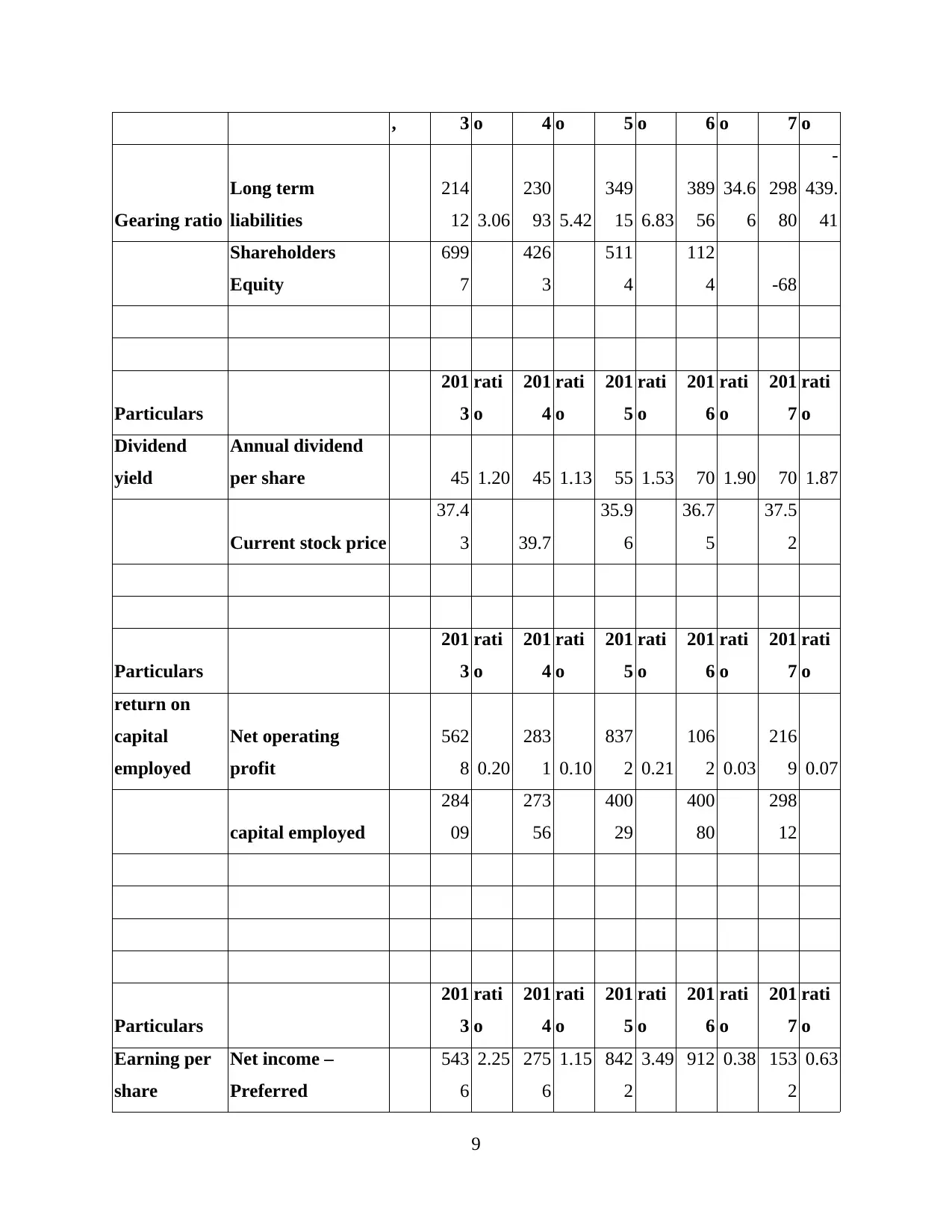
, 3 o 4 o 5 o 6 o 7 o
Gearing ratio
Long term
liabilities
214
12 3.06
230
93 5.42
349
15 6.83
389
56
34.6
6
298
80
-
439.
41
Shareholders
Equity
699
7
426
3
511
4
112
4 -68
Particulars
201
3
rati
o
201
4
rati
o
201
5
rati
o
201
6
rati
o
201
7
rati
o
Dividend
yield
Annual dividend
per share 45 1.20 45 1.13 55 1.53 70 1.90 70 1.87
Current stock price
37.4
3 39.7
35.9
6
36.7
5
37.5
2
Particulars
201
3
rati
o
201
4
rati
o
201
5
rati
o
201
6
rati
o
201
7
rati
o
return on
capital
employed
Net operating
profit
562
8 0.20
283
1 0.10
837
2 0.21
106
2 0.03
216
9 0.07
capital employed
284
09
273
56
400
29
400
80
298
12
Particulars
201
3
rati
o
201
4
rati
o
201
5
rati
o
201
6
rati
o
201
7
rati
o
Earning per
share
Net income –
Preferred
543
6
2.25 275
6
1.15 842
2
3.49 912 0.38 153
2
0.63
9
Gearing ratio
Long term
liabilities
214
12 3.06
230
93 5.42
349
15 6.83
389
56
34.6
6
298
80
-
439.
41
Shareholders
Equity
699
7
426
3
511
4
112
4 -68
Particulars
201
3
rati
o
201
4
rati
o
201
5
rati
o
201
6
rati
o
201
7
rati
o
Dividend
yield
Annual dividend
per share 45 1.20 45 1.13 55 1.53 70 1.90 70 1.87
Current stock price
37.4
3 39.7
35.9
6
36.7
5
37.5
2
Particulars
201
3
rati
o
201
4
rati
o
201
5
rati
o
201
6
rati
o
201
7
rati
o
return on
capital
employed
Net operating
profit
562
8 0.20
283
1 0.10
837
2 0.21
106
2 0.03
216
9 0.07
capital employed
284
09
273
56
400
29
400
80
298
12
Particulars
201
3
rati
o
201
4
rati
o
201
5
rati
o
201
6
rati
o
201
7
rati
o
Earning per
share
Net income –
Preferred
543
6
2.25 275
6
1.15 842
2
3.49 912 0.38 153
2
0.63
9
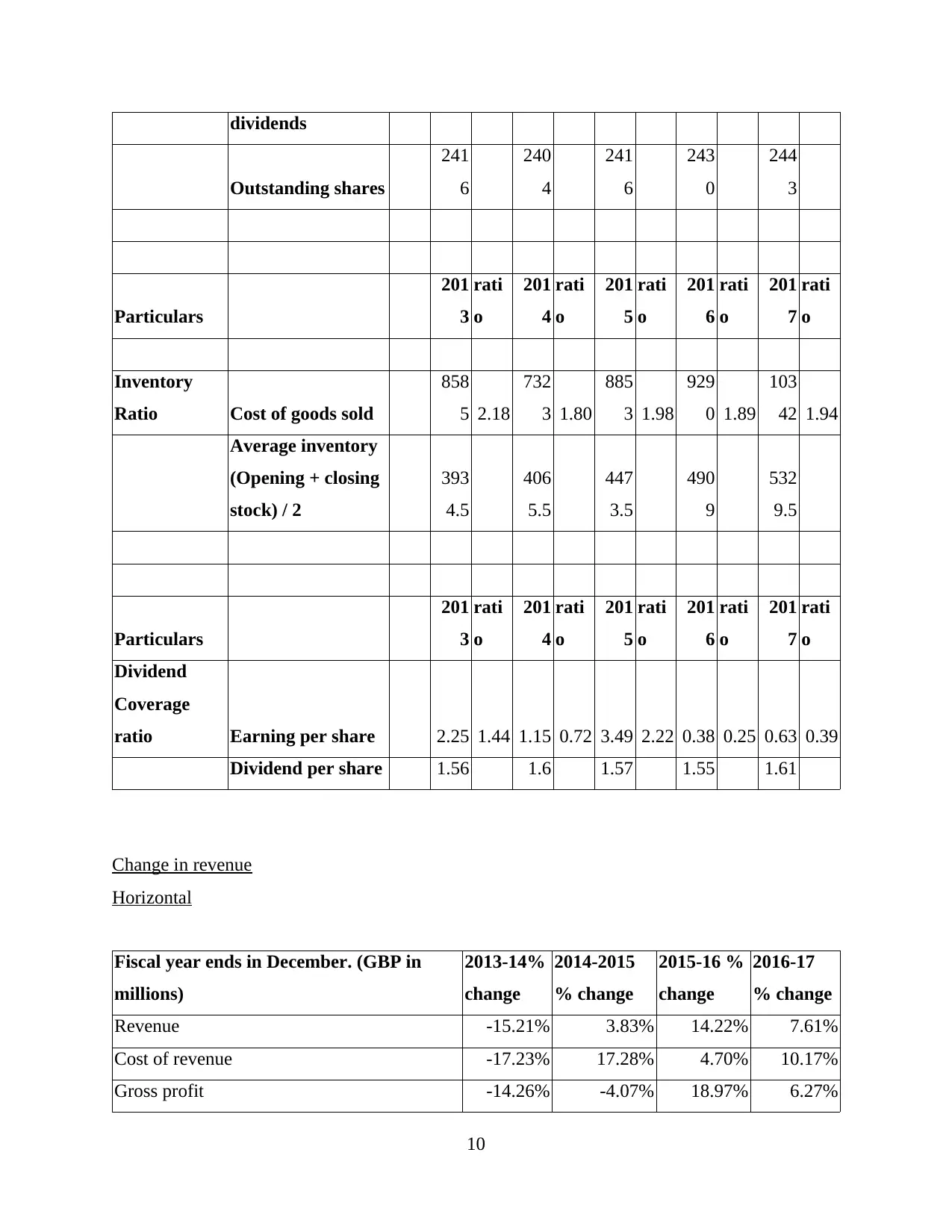
dividends
Outstanding shares
241
6
240
4
241
6
243
0
244
3
Particulars
201
3
rati
o
201
4
rati
o
201
5
rati
o
201
6
rati
o
201
7
rati
o
Inventory
Ratio Cost of goods sold
858
5 2.18
732
3 1.80
885
3 1.98
929
0 1.89
103
42 1.94
Average inventory
(Opening + closing
stock) / 2
393
4.5
406
5.5
447
3.5
490
9
532
9.5
Particulars
201
3
rati
o
201
4
rati
o
201
5
rati
o
201
6
rati
o
201
7
rati
o
Dividend
Coverage
ratio Earning per share 2.25 1.44 1.15 0.72 3.49 2.22 0.38 0.25 0.63 0.39
Dividend per share 1.56 1.6 1.57 1.55 1.61
Change in revenue
Horizontal
Fiscal year ends in December. (GBP in
millions)
2013-14%
change
2014-2015
% change
2015-16 %
change
2016-17
% change
Revenue -15.21% 3.83% 14.22% 7.61%
Cost of revenue -17.23% 17.28% 4.70% 10.17%
Gross profit -14.26% -4.07% 18.97% 6.27%
10
Outstanding shares
241
6
240
4
241
6
243
0
244
3
Particulars
201
3
rati
o
201
4
rati
o
201
5
rati
o
201
6
rati
o
201
7
rati
o
Inventory
Ratio Cost of goods sold
858
5 2.18
732
3 1.80
885
3 1.98
929
0 1.89
103
42 1.94
Average inventory
(Opening + closing
stock) / 2
393
4.5
406
5.5
447
3.5
490
9
532
9.5
Particulars
201
3
rati
o
201
4
rati
o
201
5
rati
o
201
6
rati
o
201
7
rati
o
Dividend
Coverage
ratio Earning per share 2.25 1.44 1.15 0.72 3.49 2.22 0.38 0.25 0.63 0.39
Dividend per share 1.56 1.6 1.57 1.55 1.61
Change in revenue
Horizontal
Fiscal year ends in December. (GBP in
millions)
2013-14%
change
2014-2015
% change
2015-16 %
change
2016-17
% change
Revenue -15.21% 3.83% 14.22% 7.61%
Cost of revenue -17.23% 17.28% 4.70% 10.17%
Gross profit -14.26% -4.07% 18.97% 6.27%
10
⊘ This is a preview!⊘
Do you want full access?
Subscribe today to unlock all pages.

Trusted by 1+ million students worldwide
1 out of 13
Related Documents
Your All-in-One AI-Powered Toolkit for Academic Success.
+13062052269
info@desklib.com
Available 24*7 on WhatsApp / Email
![[object Object]](/_next/static/media/star-bottom.7253800d.svg)
Unlock your academic potential
Copyright © 2020–2025 A2Z Services. All Rights Reserved. Developed and managed by ZUCOL.





